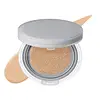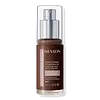What's inside
What's inside
 Key Ingredients
Key Ingredients

 Benefits
Benefits

 Concerns
Concerns

 Ingredients Side-by-side
Ingredients Side-by-side

Water
Skin ConditioningCyclopentasiloxane
EmollientTitanium Dioxide
Cosmetic ColorantMethyl Trimethicone
Skin ConditioningPropanediol
SolventButyloctyl Salicylate
Skin ConditioningPEG-10 Dimethicone
Skin ConditioningDimethicone
EmollientNiacinamide
SmoothingTrimethylsiloxysilicate
EmollientIsododecane
EmollientTrisiloxane
Skin ConditioningMagnesium Sulfate
Methyl Methacrylate Crosspolymer
Ethylhexyl Methoxycinnamate
UV AbsorberLauryl PEG-10 Tris(Trimethylsiloxy)Silylethyl Dimethicone
EmulsifyingDisteardimonium Hectorite
Stabilising1,2-Hexanediol
Skin ConditioningDiphenyl Dimethicone/Vinyl Diphenyl Dimethicone/Silsesquioxane Crosspolymer
Caprylic/Capric Glycerides
EmollientPolymethylsilsesquioxane
CI 77492
Cosmetic ColorantAluminum Hydroxide
EmollientTriethoxycaprylylsilane
CI 77491
Cosmetic ColorantButylene Glycol
HumectantPolysilicone-11
Adenosine
Skin ConditioningCI 77499
Cosmetic ColorantPolyglutamic Acid
Skin ConditioningChamaecyparis Obtusa Water
MaskingTocopherol
AntioxidantHyaluronic Acid
HumectantParfum
MaskingCI 77891
Cosmetic ColorantWater, Cyclopentasiloxane, Titanium Dioxide, Methyl Trimethicone, Propanediol, Butyloctyl Salicylate, PEG-10 Dimethicone, Dimethicone, Niacinamide, Trimethylsiloxysilicate, Isododecane, Trisiloxane, Magnesium Sulfate, Methyl Methacrylate Crosspolymer, Ethylhexyl Methoxycinnamate, Lauryl PEG-10 Tris(Trimethylsiloxy)Silylethyl Dimethicone, Disteardimonium Hectorite, 1,2-Hexanediol, Diphenyl Dimethicone/Vinyl Diphenyl Dimethicone/Silsesquioxane Crosspolymer, Caprylic/Capric Glycerides, Polymethylsilsesquioxane, CI 77492, Aluminum Hydroxide, Triethoxycaprylylsilane, CI 77491, Butylene Glycol, Polysilicone-11, Adenosine, CI 77499, Polyglutamic Acid, Chamaecyparis Obtusa Water, Tocopherol, Hyaluronic Acid, Parfum, CI 77891
Water
Skin ConditioningCyclopentasiloxane
EmollientPhenyl Trimethicone
Skin ConditioningSqualane
EmollientPEG-10 Dimethicone
Skin ConditioningNeopentyl Glycol Diheptanoate
EmollientPropanediol
SolventPPG-24-Glycereth-24
EmulsifyingTrimethylsiloxysilicate
EmollientDimethicone
EmollientGlycerin
HumectantLecithin
EmollientMagnesium Sulfate
1,2-Hexanediol
Skin ConditioningAmmonium Acryloyldimethyltaurate/Vp Copolymer
C11-15 Alketh-40
CleansingC11-15 Pareth-7
EmulsifyingCamellia Sinensis Leaf Extract
AntimicrobialCaprylic/Capric Triglyceride
MaskingCaprylyl Glycol
EmollientDisteardimonium Hectorite
StabilisingEthylene/Acrylic Acid Copolymer
Emulsion StabilisingGlycyrrhiza Glabra Root Extract
BleachingHaematococcus Pluvialis Extract
AntioxidantLithospermum Erythrorhizon Root Extract
Skin ConditioningPEG/PPG-18/18 Dimethicone
EmulsifyingPolysilicone-11
Simethicone
EmollientSodium Hyaluronate
HumectantSodium Laureth-12 Sulfate
CleansingStyrene/Acrylates Copolymer
Tetrasodium EDTA
Tocopheryl Acetate
AntioxidantTriethoxycaprylylsilane
Triethyl Citrate
MaskingPhenoxyethanol
PreservativeCI 77163
Cosmetic ColorantCI 77491
Cosmetic ColorantCI 77492
Cosmetic ColorantCI 77499
Cosmetic ColorantCI 77891
Cosmetic ColorantWater, Cyclopentasiloxane, Phenyl Trimethicone, Squalane, PEG-10 Dimethicone, Neopentyl Glycol Diheptanoate, Propanediol, PPG-24-Glycereth-24, Trimethylsiloxysilicate, Dimethicone, Glycerin, Lecithin, Magnesium Sulfate, 1,2-Hexanediol, Ammonium Acryloyldimethyltaurate/Vp Copolymer, C11-15 Alketh-40, C11-15 Pareth-7, Camellia Sinensis Leaf Extract, Caprylic/Capric Triglyceride, Caprylyl Glycol, Disteardimonium Hectorite, Ethylene/Acrylic Acid Copolymer, Glycyrrhiza Glabra Root Extract, Haematococcus Pluvialis Extract, Lithospermum Erythrorhizon Root Extract, PEG/PPG-18/18 Dimethicone, Polysilicone-11, Simethicone, Sodium Hyaluronate, Sodium Laureth-12 Sulfate, Styrene/Acrylates Copolymer, Tetrasodium EDTA, Tocopheryl Acetate, Triethoxycaprylylsilane, Triethyl Citrate, Phenoxyethanol, CI 77163, CI 77491, CI 77492, CI 77499, CI 77891
 Reviews
Reviews

Ingredients Explained
These ingredients are found in both products.
Ingredients higher up in an ingredient list are typically present in a larger amount.
1,2-Hexanediol is a synthetic liquid and another multi-functional powerhouse.
It is a:
- Humectant, drawing moisture into the skin
- Emollient, helping to soften skin
- Solvent, dispersing and stabilizing formulas
- Preservative booster, enhancing the antimicrobial activity of other preservatives
Ci 77491 is also hydrated iron III oxide. It's sole purpose is to give a red/pink hue to products.
Iron III oxides are classified as inorganic chemicals for coloring.
Synthetically created Ci 77491 is considered safer than those naturally found. This is because the synthetically created version may contain less impurities. Iron oxides are generally non-toxic and non-allergenic.
Learn more about CI 77491Ci 77492 is also hydrated iron III oxide. It's sole purpose is to give a yellow hue to products.
Iron III oxides are classified as inorganic chemicals for coloring.
Synthetically created Ci 77492 is considered safer than those naturally found. This is because the synthetically created version may contain less impurities. Iron oxides are generally non-toxic and non-allergenic.
Learn more about CI 77492Ci 77499 is also hydrated iron III oxide. It is created from mixing red and black iron oxides. This helps give shades of darkness to a product.
Iron III oxides are classified as inorganic chemicals for coloring.
Ci 77891 is a white pigment from Titanium dioxide. It is naturally found in minerals such as rutile and ilmenite.
It's main function is to add a white color to cosmetics. It can also be mixed with other colors to create different shades.
Ci 77891 is commonly found in sunscreens due to its ability to block UV rays.
Learn more about CI 77891Cyclopentasiloxane, or D5, is a silicone used to improve texture of products and trap moisture.
D5 is considered lightweight and volatile. Volatile means it evaporates quickly after application. Once evaporated, D5 leaves a thin barrier that helps keep skin hydrated.
It is also an emollient. Emollients help soften the skin and prevent water loss. Silicones create a silky texture in products. D5 helps other ingredients become more spreadable.
Studies show D5 is safe to use in skincare products. We recommend speaking with a skincare professional if you have concerns.
Learn more about CyclopentasiloxaneDimethicone is a type of synthetic silicone created from natural materials such as quartz.
What it does:
Dimethicone comes in different viscosities:
Depending on the viscosity, dimethicone has different properties.
Ingredients lists don't always show which type is used, so we recommend reaching out to the brand if you have questions about the viscosity.
This ingredient is unlikely to cause irritation because it does not get absorbed into skin. However, people with silicone allergies should be careful about using this ingredient.
Note: Dimethicone may contribute to pilling. This is because it is not oil or water soluble, so pilling may occur when layered with products. When mixed with heavy oils in a formula, the outcome is also quite greasy.
Learn more about DimethiconeDisteardimonium Hectorite comes from the clay mineral named hectorite. It is used to add thickness to a product.
It can also help stabilize a product by helping to disperse other ingredients.
Hectorite is a rare, white clay mineral.
Learn more about Disteardimonium HectoriteMagnesium Sulfate is a salt. More specifically, it is an epsom salt, or the bath salt used to help relieve muscle aches.
Despite having ‘sulfate’ in the name, it isn’t a surfactant or cleansing agent like sodium lauryl sulfate. Unlike those sulfates, magnesium sulfate doesn’t have the same cleansing or foaming properties (it's simply a type of salt).
In cosmetics, Magnesium Sulfate is used to thicken a product or help dilute other solids. It is a non-reactive and non-irritating ingredient.
One study shows magnesium deficiency may lead to inflammation of the skin. Applying magnesium topically may help reduce inflammation.
You can find this ingredient in sea water or mineral deposits.
Learn more about Magnesium SulfatePeg-10 Dimethicone is silicone with conditioner and emulsifier properties. It mostly acts as an emollient in skincare and and humectant in haircare.
According to the manufacturer, acidic formulations decrease the stability of this ingredient. It works best in neutral or near neutral formulations.
Polysilicone-11 is a film-forming silicone that creates a non-tacky and matte finish on the skin. It's commonly used to improve texture, absorb excess oil, and help active ingredients spread evenly.
Due to its "rubber-like" structure, it stays on the skin's surface instead of being absorbed. On the skin, it creates a flexible layer that enhances wearability and stability.
Propanediol is an all-star ingredient. It softens, hydrates, and smooths the skin.
It’s often used to:
Propanediol is not likely to cause sensitivity and considered safe to use. It is derived from corn or petroleum with a clear color and no scent.
Learn more about PropanediolTriethoxycaprylylsilane is a silicone used to bind and stabilize ingredients.
As an emulsifier, it helps prevent ingredients from separating. This can help elongate the shelf life of products.
Triethoxycaprylylsilane is often used to coat mineral sunscreens ingredients to help give a better feel. It also helps reduce oxidative stress in sunscreens.
Learn more about TriethoxycaprylylsilaneThis silicone is an emollient. Emollients create a thin film on the skin to prevent moisture from escaping.
It is not soluble in water and helps increase water-resistance in products.
According to a manufacturer, it can blend seamlessly with silicone oils, such as Cyclopentasiloxane.
Learn more about TrimethylsiloxysilicateWater. It's the most common cosmetic ingredient of all. You'll usually see it at the top of ingredient lists, meaning that it makes up the largest part of the product.
So why is it so popular? Water most often acts as a solvent - this means that it helps dissolve other ingredients into the formulation.
You'll also recognize water as that liquid we all need to stay alive. If you see this, drink a glass of water. Stay hydrated!
Learn more about Water